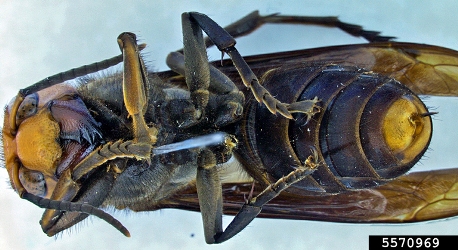

Consider buying an advertisement for your business or sending a donation to Pike County Times to support the only free online newspaper in Pike County. Donations can be sent to: The Pike County Times, PO Box 843, Zebulon, Georgia 30295. Click here to donate through PayPal. Thanks for supporting Pike County's only free online newspaper!

Photo courtesy of Allan Smith-Pardo, Invasive Hornets, USDA APHIS PPQ, Bugwood.org

Photo courtesy of Allan Smith-Pardo, Invasive Hornets, USDA APHIS PPQ, Bugwood.org
Courtesy of UGA Extension
ZEBULON - A flurry of recent press coverage has created a surge of interest in the Asian giant hornet, Vespa mandarinia. The coverage is not traced to any recent event. The insect was found last September 2019 in Vancouver Island (Canada) and again in December 2019 in Washington state. But to date, this invasive insect is not present in the state of Georgia, nor indeed, east of the Mississippi.
The Asian giant hornet is a “true” hornet and the world’s largest, ranging in size from 1.5 to slightly over 2 inches long (38-50mm). The stinger is nearly ¼-inch long and stings are extremely painful. Each year in Japan, 30-50 people die from being stung by these hornets. The venom is not the most lethal among bees and wasps, but due to the insect’s large size, the dose is larger than any other stinging insect Americans typically encounter. Human sting deaths are biased toward individuals who are prone to anaphylactic reactions or to individuals who receive large numbers of stings. One or a few stings from an Asian giant hornet should not be life-threatening to an average individual.
The Asian giant hornet is not necessarily aggressive towards humans, livestock or pets but will sting if provoked. However, this giant killer can inflict a devastating blow to honey bee colonies, with several hornets capable of annihilating 30,000 bees within hours. There are three phases to an Asian giant hornet attacking a honey bee colony. The first is the hunting phase where individual hornets will capture bees at the entrance of the colony, cut off their heads, and form a “meat ball” from the thorax. They then return to their nest to feed their young this protein-rich meal.
The second phase is the slaughter phase. Hornets will mark a particular colony with a pheromone to recruit their sisters to the site. Then numerous hornets will descend upon the colony, killing all of the workers by ripping their heads off, dumping their bodies onto the ground below, and returning to their nest with their prey.
Once the bee hive is dead, hornets enter the occupation phase. Hornets take over the hive, collect pupae and larvae, and return to their own nest to feed their carnivorous young. The hornets now guard the hive entrance as if it were their own nest. The aftermath of an attack will be piles of decapitated or ripped apart bees in front of a colony. The visible key to an Asian giant hornet attack is “decapitated” or “ripped apart” bees, and not just a pile of intact dead bees, which could be the result of pesticides, starvation or something else.
This is the hornet that incites the famous bee defensive response of “cooking” hornets to death. Asian honey bees grab an invading hornet, pile around it and raise their thoracic temperatures to the critical temperature that is lethal to wasps but tolerable to bees. Unfortunately, American honey bees, of European not Asiatic descent, do not have this behavior.
The Asian giant hornet’s life cycle is typical of that for other social wasps and yellowjackets. A solitary female emerges from winter hibernation and founds a subterranean nest, at first performing all nest duties including foraging and incubating the young. The colony steadily grows until workers eventually take over all foraging duties. New queens and males emerge in late summer and mate. Eventually the males and workers die, leaving only the newly-mated queens who overwinter in isolation.
At this time there have been no confirmed cases of this hornet’s presence in Georgia or anywhere outside of Washington state. Other wasps and hornets already residents in our state that may be confused with the Asian giant hornet are:
· Cicada killers, Sphecius speciosus, size range 0.6 – 2 inches long (15 – 50mm)
· European hornets, Vespa crabro, size range 1-1.4 inches (25-35mm)
· Southern yellowjackets, Vespula squamosa, size range 0.5inches (12mm)
· Baldfaced hornets, Dolichovespula maculata, size range 0.75 inches (19mm)
The Asian giant hornet and cicada killer may be similar in size but very different in coloration. The Center for Invasive Species and Ecosystem Health have put together an “Asian Giant Hornet and its SE US Lookalikes” photographic fact sheet (link below) which is extremely helpful for distinguishing between the different species in our state.
At this time, we need to be vigilant but not over-reactive since, again, there is no evidence that the Asian giant hornet has journeyed East. However, sightings and/or disturbances to honey bee colonies should be reported. If you think you have seen an Asian giant hornet, found evidence of an attack (decapitated or ripped apart bees) or have a specimen, please contact your County Extension Agent immediately. They will be able to collect your information and any specimens for identification. You can call Pike County Agent, Brooklyne Wassel at (678) 588-3153.
For photos and more in-depth information about the Asian giant hornet, please check out the following:
Click here to read the Georgia Department of Agriculture's fact sheet on these invasive pests and see some look alikes that live here in our area.
Click here to see pictures of this creature.
For further information, please contact Brooklyne Wassel, University of Georgia Extension- Pike County | Agriculture and Natural Resources Agent by phone at 770-567-2010 or email at brooklyne.wassel@uga.edu.